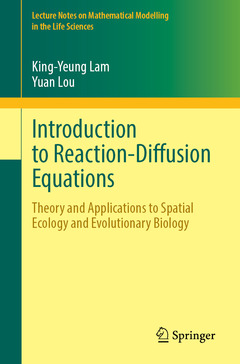Introduction to Reaction-Diffusion Equations, 1st ed. 2022 Theory and Applications to Spatial Ecology and Evolutionary Biology Lecture Notes on Mathematical Modelling in the Life Sciences Series
Auteurs : Lam King-Yeung, Lou Yuan

This book introduces some basic mathematical tools in reaction-diffusion models, with applications to spatial ecology and evolutionary biology. It is divided into four parts.
The first part is an introduction to the maximum principle, the theory of principal eigenvalues for elliptic and periodic-parabolic equations and systems, and the theory of principal Floquet bundles.
The second part concerns the applications in spatial ecology. We discuss the dynamics of a single species and two competing species, as well as some recent progress on N competing species in bounded domains. Some related results on stream populations and phytoplankton populations are also included. We also discuss the spreading properties of a single species in an unbounded spatial domain, as modeled by the Fisher-KPP equation.
The third part concerns the applications in evolutionary biology. We describe the basic notions of adaptive dynamics, such as evolutionarily stable strategies and evolutionary branching points, in the context of a competition model of stream populations. We also discuss a class of selection-mutation models describing a population structured along a continuous phenotypical trait.The fourth part consists of several appendices, which present a self-contained treatment of some basic abstract theories in functional analysis and dynamical systems. Topics include the Krein-Rutman theorem for linear and nonlinear operators, as well as some elements of monotone dynamical systems and abstract competition systems.
Most of the book is self-contained and it is aimed at graduate students and researchers who are interested in the theory and applications of reaction-diffusion equations.
King-Yeung Lam is associate professor of mathematics at the Ohio State University. His areas of specialization are partial differential equations and mathematical biology. He has worked on the mathematical aspects of competition of multiple species, evolution of dispersal, asymptotic spreading of species, population dynamics of phytoplankton species, as well as free boundary problems describing cancer and a range of diseases.
Yuan Lou is professor of mathematics at Shanghai Jiao Tong University. His areas of specialization are partial differential equations and mathematical biology. He has worked on the mathematical aspects of cross-diffusion systems, Lotka-Volterra competition models with diffusion, population dynamics of phytoplankton species, and the modeling and analysis of infectious diseases. He is the former associate director of the Mathematical Biosciences Institute at the Ohio State University, and the founding director of the Institute for Mathematical Sciences at Renmin University of China.
Bridges the gap between biological research on dynamical systems and the theory of PDEs
Contains challenging current research topics in mathematical biology
Based on a mini-course given at Institut Henri Poincaré
Date de parution : 12-2022
Ouvrage de 312 p.
15.5x23.5 cm



